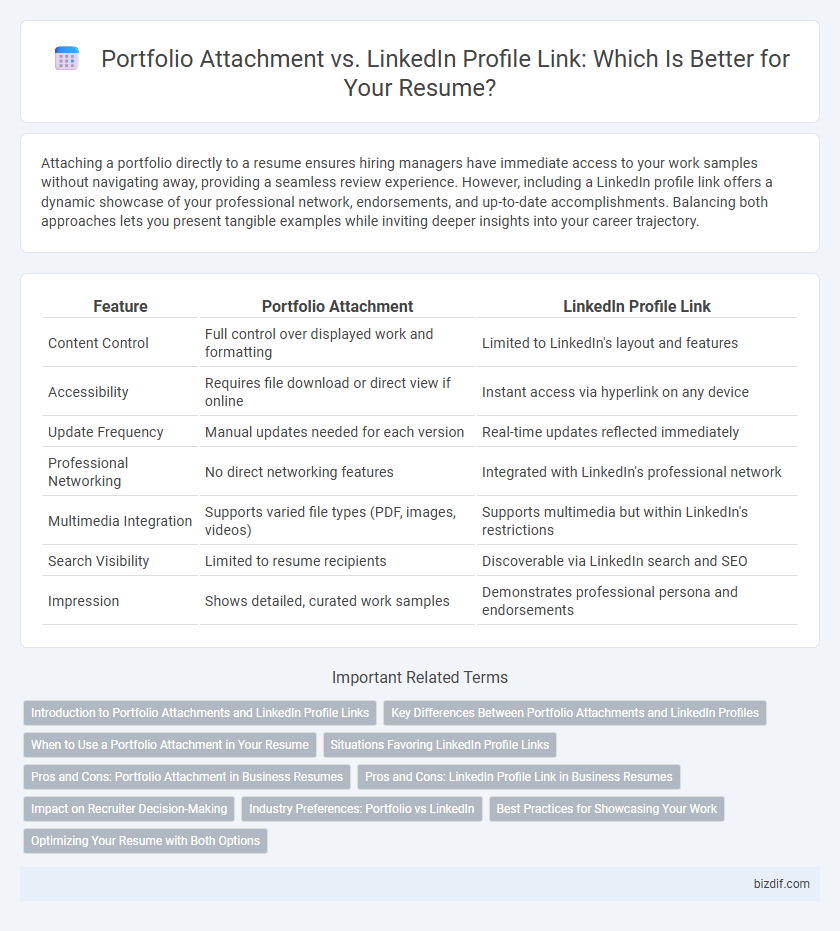Attaching a portfolio directly to a resume ensures hiring managers have immediate access to your work samples without navigating away, providing a seamless review experience. However, including a LinkedIn profile link offers a dynamic showcase of your professional network, endorsements, and up-to-date accomplishments. Balancing both approaches lets you present tangible examples while inviting deeper insights into your career trajectory.
Table of Comparison
| Feature | Portfolio Attachment | LinkedIn Profile Link |
|---|---|---|
| Content Control | Full control over displayed work and formatting | Limited to LinkedIn's layout and features |
| Accessibility | Requires file download or direct view if online | Instant access via hyperlink on any device |
| Update Frequency | Manual updates needed for each version | Real-time updates reflected immediately |
| Professional Networking | No direct networking features | Integrated with LinkedIn's professional network |
| Multimedia Integration | Supports varied file types (PDF, images, videos) | Supports multimedia but within LinkedIn's restrictions |
| Search Visibility | Limited to resume recipients | Discoverable via LinkedIn search and SEO |
| Impression | Shows detailed, curated work samples | Demonstrates professional persona and endorsements |
Introduction to Portfolio Attachments and LinkedIn Profile Links
Portfolio attachments provide a tangible demonstration of skills and projects, enabling recruiters to assess candidates' work quality directly within the resume. LinkedIn profile links offer a dynamic and expandable representation of professional history, recommendations, and network connections that complement the static resume content. Including both options enhances credibility and allows employers to explore candidates' qualifications more comprehensively.
Key Differences Between Portfolio Attachments and LinkedIn Profiles
Portfolio attachments showcase curated work samples tailored to specific job applications, highlighting technical skills and project outcomes in a tangible format. LinkedIn profiles offer a dynamic, interactive representation of professional history, endorsements, and networking connections accessible to a broader audience. Portfolios provide detailed evidence of expertise, while LinkedIn emphasizes professional branding and relationship building.
When to Use a Portfolio Attachment in Your Resume
Including a portfolio attachment in your resume is essential when applying for creative roles such as graphic design, writing, or web development, where showcasing tangible work samples directly influences hiring decisions. Recruiters benefit from an attached portfolio to quickly assess skills and style without navigating external sites, enhancing immediacy and impact. Use a portfolio attachment when your work's visual or detailed presentation strengthens your candidacy more effectively than a LinkedIn profile link.
Situations Favoring LinkedIn Profile Links
LinkedIn profile links are favored in situations where real-time updates and professional networking visibility are crucial, such as job applications in dynamic industries like technology or marketing. Recruiters prioritize LinkedIn for its endorsement features, recommendations, and comprehensive career history that provide a multidimensional view of candidates. This digital presence also enables seamless integration with applicant tracking systems and mobile-friendly access, enhancing convenience and engagement.
Pros and Cons: Portfolio Attachment in Business Resumes
Including a portfolio attachment in business resumes provides concrete evidence of skills and accomplishments, allowing recruiters to directly assess work samples relevant to the job. However, portfolios can increase file sizes and may be overlooked if recruiters prefer quick digital links, reducing immediate accessibility compared to a LinkedIn profile link. While LinkedIn profiles offer real-time updates and endorsements, portfolios offer a controlled, curated presentation that highlights key achievements without distractions.
Pros and Cons: LinkedIn Profile Link in Business Resumes
Including a LinkedIn profile link in business resumes offers instant access to a dynamic, professional online presence showcasing endorsements, recommendations, and a comprehensive work history, enhancing credibility and networking opportunities. However, relying solely on a LinkedIn link may expose applicants to incomplete or outdated information and lacks the personalized, curated presentation of skills and projects that a portfolio attachment provides. Recruiters often prefer portfolios for detailed evidence of work quality, while LinkedIn profiles are valuable for verifying qualifications and professional connections.
Impact on Recruiter Decision-Making
Including a portfolio attachment in a resume provides tangible proof of skills and projects, allowing recruiters to quickly assess the quality and relevance of work. A LinkedIn profile link offers a dynamic overview of professional history, endorsements, and network connections, enhancing credibility through social validation. Combining both elements can significantly influence recruiter decision-making by delivering comprehensive evidence of expertise and professional presence.
Industry Preferences: Portfolio vs LinkedIn
Industry preferences reveal that creative fields such as design, photography, and marketing prioritize portfolio attachments to showcase tangible work samples, skills, and visual storytelling. Conversely, corporate sectors like finance, consulting, and technology often favor LinkedIn profile links, emphasizing professional endorsements, network size, and updated career milestones. Tailoring the application by aligning with industry norms--attaching a portfolio for creative roles or sharing a LinkedIn profile for corporate positions--enhances credibility and hiring prospects.
Best Practices for Showcasing Your Work
Include a portfolio attachment in your resume to provide direct, organized access to your best projects, demonstrating your skills through tangible examples. Linking to your LinkedIn profile offers dynamic, up-to-date content, endorsements, and network connections that validate your professional experience. Combine both by embedding a concise portfolio link with a well-maintained LinkedIn profile for maximum impact and credibility.
Optimizing Your Resume with Both Options
Including both a portfolio attachment and a LinkedIn profile link on your resume enhances your personal brand by showcasing verified skills and tangible work samples. A portfolio attachment offers direct evidence of your expertise through projects, designs, or reports, while a LinkedIn profile provides dynamic recommendations, endorsements, and a comprehensive career history. Combining these elements optimizes your resume's effectiveness, increasing credibility and engagement with potential employers.
Portfolio Attachment vs LinkedIn Profile Link Infographic

 bizdif.com
bizdif.com